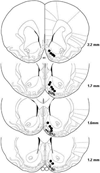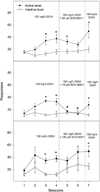The reinforcing effects of ethanol within the nucleus accumbens shell involve activation of local GABA and serotonin receptors
- PMID: 25922425
- PMCID: PMC4677478
- DOI: 10.1177/0269881115581982
The reinforcing effects of ethanol within the nucleus accumbens shell involve activation of local GABA and serotonin receptors
Abstract
Ethanol is reinforcing within the nucleus accumbens shell (NACsh), but the underlying mechanisms remain unclear. Ethanol can potentiate the function of the GABAA, GABAB, and serotonin-3 (5-HT3) receptors. Therefore, the current study tested the hypothesis that activation of these receptors would be involved in the reinforcing effects of ethanol in the NACsh. An intracranial self-administration (ICSA) procedure was used to assess the reinforcing effects of ethanol in the NACsh of alcohol preferring (P) rats. The ICSA consisted of seven sessions: four sessions to establish 150 mg% ethanol self-infusion into the NACsh; sessions 5 and 6 with co-infusion of ethanol plus one concentration of the GABAA antagonist bicuculline (10 or 100 µM), the GABAB antagonist SCH 50911 (50, 75 or 100 µM), or the 5-HT3 receptor antagonist zacopride (10 or 100 µM); and session 7 with 150 mg% ethanol alone. All groups self-infused ethanol into the NACsh and readily discriminated the active from inactive lever during the acquisition sessions. Co-infusion of 100 µM, but not 10 µM, bicuculline or zacopride significantly decreased active responses during sessions 5 and 6. Co-infusion of 75 µM, but not 50 or 100 µM, SCH 50911 significantly attenuated responses for ethanol. Overall, the results suggest that the reinforcing effects of ethanol in the NACsh may be modulated by activation of local GABAA, GABAB and 5-HT3 receptors.
Keywords: GABAA receptor; GABAB receptor; Intracranial self-administration; ethanol; nucleus accumbens; serotonin receptor.
© The Author(s) 2015.
Conflict of interest statement
The authors declare that there is no conflict of interest.
Figures




Similar articles
-
Effects of serotonin-3 receptor antagonists on the intracranial self-administration of ethanol within the ventral tegmental area of Wistar rats.Psychopharmacology (Berl). 2003 Jan;165(3):252-9. doi: 10.1007/s00213-002-1300-2. Epub 2002 Nov 23. Psychopharmacology (Berl). 2003. PMID: 12447605
-
Salsolinol produces reinforcing effects in the nucleus accumbens shell of alcohol-preferring (P) rats.Alcohol Clin Exp Res. 2003 Mar;27(3):440-9. doi: 10.1097/01.ALC.0000056612.89957.B4. Alcohol Clin Exp Res. 2003. PMID: 12658109
-
Involvement of local serotonin-2A but not serotonin-1B receptors in the reinforcing effects of ethanol within the posterior ventral tegmental area of female Wistar rats.Psychopharmacology (Berl). 2009 Jun;204(3):381-90. doi: 10.1007/s00213-009-1468-9. Epub 2009 Jan 23. Psychopharmacology (Berl). 2009. PMID: 19165471 Free PMC article.
-
Regional heterogeneity for the intracranial self-administration of ethanol and acetaldehyde within the ventral tegmental area of alcohol-preferring (P) rats: involvement of dopamine and serotonin.Neuropsychopharmacology. 2005 Feb;30(2):330-8. doi: 10.1038/sj.npp.1300561. Neuropsychopharmacology. 2005. PMID: 15383830
-
The reinforcing effects of ethanol within the posterior ventral tegmental area depend on dopamine neurotransmission to forebrain cortico-limbic systems.Addict Biol. 2015 May;20(3):458-68. doi: 10.1111/adb.12138. Epub 2014 Mar 27. Addict Biol. 2015. PMID: 24674134 Free PMC article.
Cited by
-
Neuroplasticity and Multilevel System of Connections Determine the Integrative Role of Nucleus Accumbens in the Brain Reward System.Int J Mol Sci. 2021 Sep 10;22(18):9806. doi: 10.3390/ijms22189806. Int J Mol Sci. 2021. PMID: 34575969 Free PMC article. Review.
-
Distribution of Serotonergic Transporter Innervation in the Nucleus Accumbens and Ventral Pallidum Is Highly Conserved Among Primates.J Comp Neurol. 2025 Aug;533(8):e70083. doi: 10.1002/cne.70083. J Comp Neurol. 2025. PMID: 40852912 Free PMC article.
-
Brain region-specific neuromedin U signalling regulates alcohol-related behaviours and food intake in rodents.Addict Biol. 2020 May;25(3):e12764. doi: 10.1111/adb.12764. Epub 2019 May 8. Addict Biol. 2020. PMID: 31069918 Free PMC article.
-
Suppressing effect of COR659 on alcohol, sucrose, and chocolate self-administration in rats: involvement of the GABAB and cannabinoid CB1 receptors.Psychopharmacology (Berl). 2017 Sep;234(17):2525-2543. doi: 10.1007/s00213-017-4644-3. Epub 2017 May 24. Psychopharmacology (Berl). 2017. PMID: 28536867
-
Aging in nucleus accumbens and its impact on alcohol use disorders.Alcohol. 2023 Mar;107:73-90. doi: 10.1016/j.alcohol.2022.08.004. Epub 2022 Sep 7. Alcohol. 2023. PMID: 36087859 Free PMC article. Review.
References
-
- Allan AM, Huidobro-Toro JP, Bleck V, Harris RA. Alcohol and the GABA receptor-chloride channel complex of brain. Alcohol Alcohol. 1987;(Suppl 1):643–646. - PubMed
-
- Aono Y, Saigusa T, Mizoguchi N, Iwakami T, Takada K, Gionhaku N, Oi Y, Ueda K, Koshikawa N, Cools AR. Role of GABAA receptors in the endomorphine-1, but not endomorphin-2, induced dopamine efflux in the nucleus accumbens of freely moving rats. Eur J Pharmacol. 2008;580:87–94. - PubMed
-
- Barnes JM, Barnes NM, Champaneria S, Costall B, Naylor RJ. Characterisation and autoradiographic localisation of 5-HT3 recognition sites identified with [3H]-(S)-zacopride in the forebrain of the rat. Neuropharmacology. 1990;29:1037–1045. - PubMed
-
- Bolser DC, Blythin DJ, Chapman RW, Eqan RW, Hey JA, Rizzo C, Kuo SC, Kreutner W. The pharmacology of SCH 50911: a novel, orally-active GABA-B receptor antagonist. J Pharmacol Exp Ther. 1995;274:1393–1398. - PubMed
-
- Bowery NG, Hudson AL, Price GW. GABAA and GABAB receptor site distribution in the rat central nervous system. Neuroscience. 1987;20:365–383. - PubMed
Publication types
MeSH terms
Substances
Grants and funding
LinkOut - more resources
Full Text Sources
Other Literature Sources
Miscellaneous

